Conditional Quantile Regression Forests
Posted on
This note is based on the slides of the seminar, Dr. ZHU, Huichen. Conditional Quantile Random Forest.
Motivation
REactions to Acute Care and Hospitalization (REACH) study
- patients who suffer from acute coronary syndrome (ACS, 急性冠心症) are at high risk for many adverse outcomes, including recurrent cardiac (心脏的;心脏病的;心脏病患者) events, re-hospitalizations, major mental disorders, and mortality. There is an urgent need for post-discharge (出院后) chronic (长期的,慢性的) care for ACS patients.
- developing accurate predictive models for those adverse events are the first step in response to such need.
- The Columbia University Medical Center has established an on-going cohort since 2013, called the REactions to Acute Care and Hospitalization (REACH)
- Includes rich and comprehensive electronic medical records (EMRs) of 1744 ACS patients
- Provides a unique and ideal platform to develop high-dimensional statistical predictive analysis for ACS patients.
Scientific/Clinical Objectives
- one of the adverse event is post-traumatic stress disorder (PTSD), which leads to a much higher risk of recurrent cardiovascular (心血管的) events and mortality.
- about 20% of the patients in REACH cohort achieved a higher score based on a PTSD checklist within one month after emergency room (ER) discharge
- goal: to develop a statistical approach to enhance the prediction of PTSD at the time of discharge
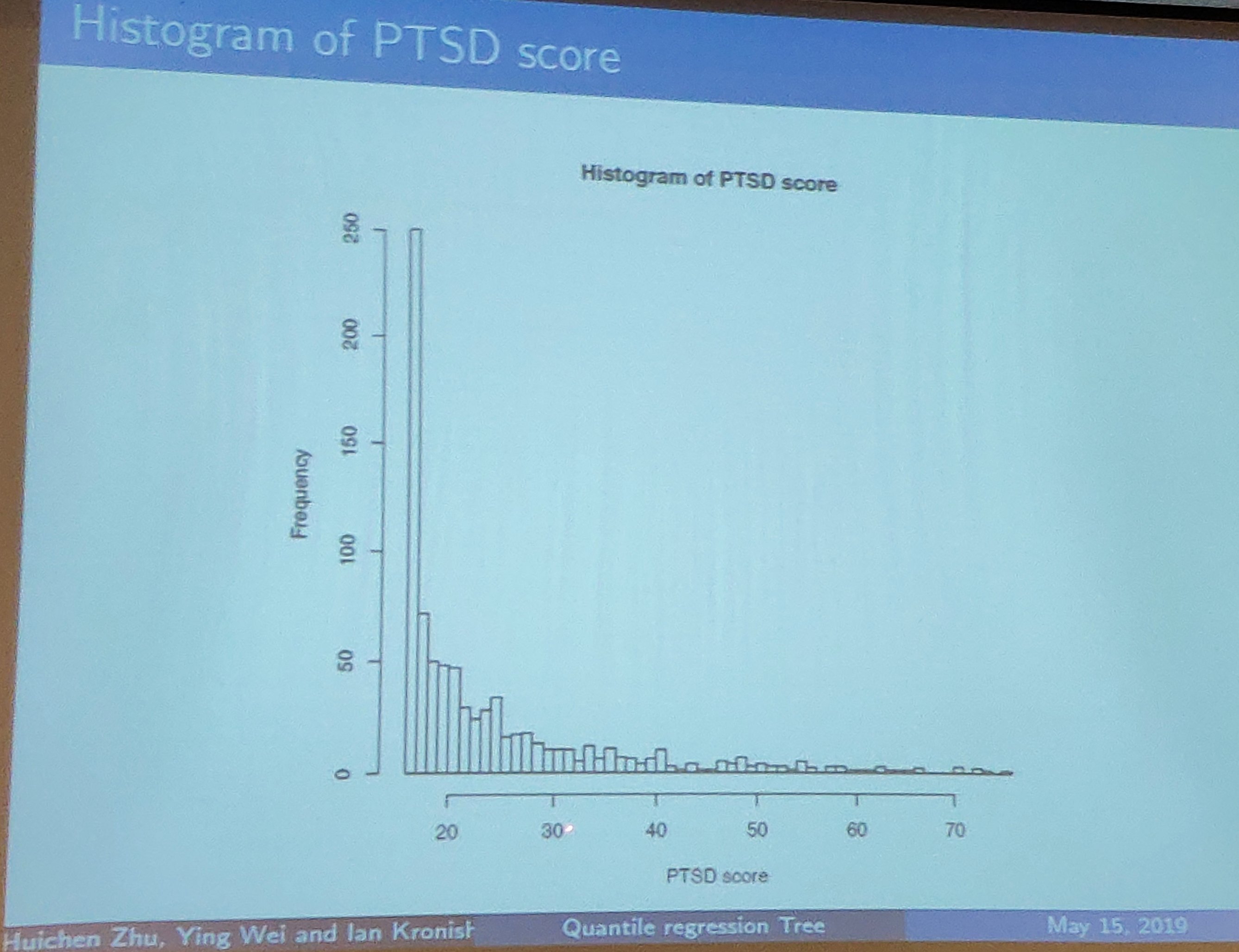
Traditional Approaches to Predict Continuous Outcome
- Linear Regression
- with a set of pre-specified key predictors
- with variable screening and selection to include a large number of potential predictors
- LASSO
- SCAD
- elastic net
- Machine learning approach
- random forest
- support vector machine
- linear discriminant analysis
- k-means clustering
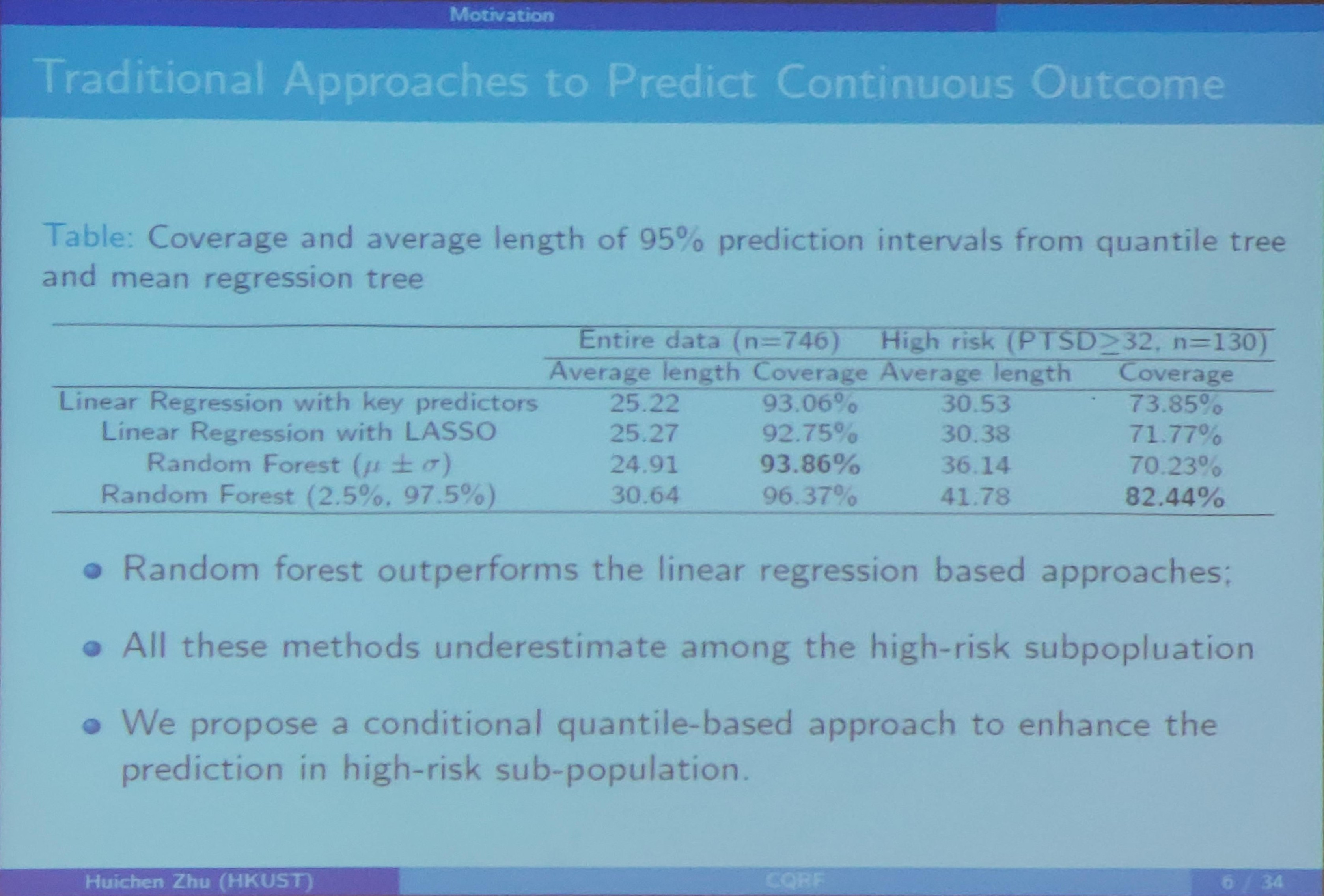
Quantile Regression
- Conditional quantile: $Q_\tau(Y\mid X)=\inf\{y:\Pr(Y\le y\mid X)\ge \alpha\}$
- Quantile regression (Koenker & Bassett Jr, 1978) is an extension of traditional linear regression
- Quantile regression allows us to study the impact of predictors on different quantiles of response distribution, and thus provides a complete picture of relationship between $Y$ and $X$.
Combine the Domain Knowledge
- Theoretical mental health for ACS survivor indicates that PTSD due to a medical event is often driven by the fear of death and recurrence
- The impact of the fear also depends on individuals
- REACH study have assessed the fear level using multiple measures during emergency room (ER) visits
- Adopting such domain knowledge into the data-driven machine learning approach is potentially another direction to improve the prediction
(??Is that fair for the previous compared methods do not combine such domain knowledge)
Existing Works
Only a few previous work involving quantile related splitting criterion or prediction in regression tree or random forest.
- Chaudhuri and Loh (2002) and Bhat et al. (2015) proposed to partition the sample using conditional quantile loss functions at a fixed quantile level
- Meinshausen (2006) proposed to use empirical functions for predictions, but individual tree is still based on CART
Proposed Methods
A Non-parametric Interactive Quantile Model for PTSD prediction
Assume a non-parametric interactive quantile model
\[Q_{y_i}(\tau, x_i, z_i) = \beta_0(\tau, x_i) + z_i^T\beta_1(\tau, x_i)\,,\]where
- $y_i$: individual post-ACS PTSD scores
- $z_i$: key predictors (level of fear during ER visit, PTSD score at baseline)
- $x_i$: a $p$-dimensional patient profile from EMR
- $\tau\in (0,1)$: the quantile level
Splitting Criterion
- For any recursive partition approach, a splitting criterion is the most crucial part.
- Classical regression tree/forest choose the optimal split that leads to the greatest reduction in Residual Sum of Squares (RSS).
- It partitions the sample into subsets with distinctive means.
Conditional Quantile-based Splitting Criterion I
Step 1
First determine a $K$ that $\tau_k = k/(K+1),k=1,2,\ldots,K$. Build a quantile regression model for each $\tau_k$ at node $N$ as
\[Q_y(\tau_k,z,x\in N) = z^T\beta_N(\tau_k, 0)\,,\]where $\beta_N(\tau_k, 0)$ is the quantile coefficient at quantile level $\tau_k$. (?? confused about the notation, why take 0 as the second argument, got the idea in the following context). Estimate each $\beta_N(\tau_k, 0)$ by
Step 2
Re-model the data in $N$ following the split $s$ as
\[Q_Y(\tau, z_i, s) = z_i^T\beta_1(\tau, s) + \delta_i(s)z_i^T\beta_2(\tau, s)\,,\]where $\beta_N(\tau, s) = (\beta_1(\tau, s)^T, \beta_2(\tau, s)^T)^T$ represents the quantile coefficients following the partition $s$, and
\[\delta_i(s) = \begin{cases} 1 & \text{$x_i$ belongs to the resulting left child node $N_L^s$}\\ 0 & \text{o.w.} \end{cases}\]Estimate each $\beta_N(\tau_k, s)$ by
\[\hat \beta_N(\tau_k, s) = \argmin_\beta L_N(s,\tau_k, \beta) = \argmin_{\beta_1,\beta_2} \frac{1}{\vert N\vert} \sum_i[\rho_{\tau_k}\left\{y_i - z_i^T\beta_1 - \delta_i(s)z_i^T\beta_2\right\}I\left\{x_i\in N\right\}]\,.\]So, it seems that $\beta_1+\beta_2$ for the left child node, while $\beta_1$ for the right child node.
Step 3
Propose the first splitting criterion, extended from the concept of RSS, in the form,
\[\Delta_N(s) = \sum_{k=1}^K\omega(\tau_k) \left\{ \frac{\hat L_N(0, \tau_k) - \hat L_N(s, \tau_k)}{\hat L_N(0, \tau_k)} \right\}\,,\]where $\hat L_N(s,\tau_k) = L_N(s, \tau_k, \hat\beta(\tau_k, s))$. The term $\omega(\tau_k)$ is a predefined weight function and reflects the relative importance across quantile levels.
Step 4
Choose the optimal split by maximizing $\Delta_N(s)$, set
\[s_N^1 = \argmax_{s} \Delta_N(s)\,.\]Splitting Criterion II
Let
\[\hat \beta_N(\tau_k, 0) = \argmin_\beta L_N(0, \tau_k, \beta)\,.\]Denote that
\[\hat R_i = \sum_{k=1}^K I\left\{ y_i-z_i^T\hat \beta_N(\tau_k, 0) \le 0\right\}\,,\]which ranges between 1 and $K$ and identifies the rank of $y_i$ with respect to the estimated conditional quantile process (?? due to $k$?) $z_i^T\hat\beta(\tau_k, 0)$.
A contingency table can be constructed based on $\hat R_i$ for each split $s$.
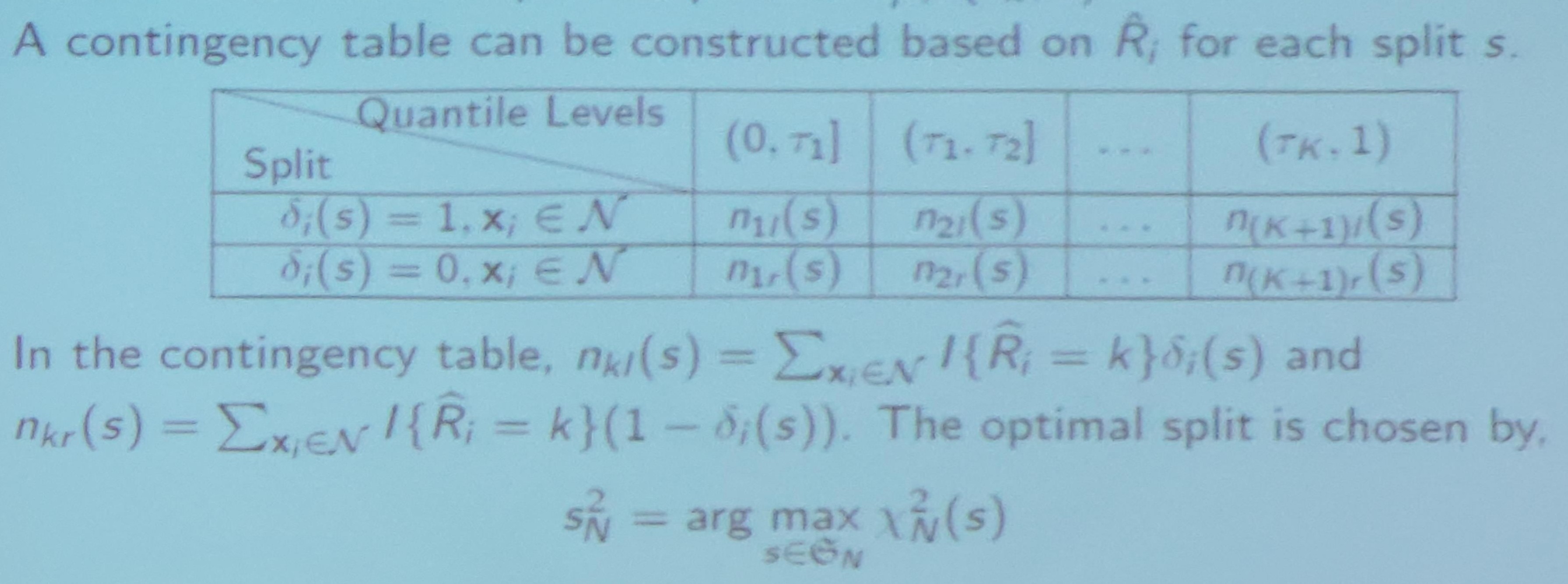
Comparing the Splitting Criteria
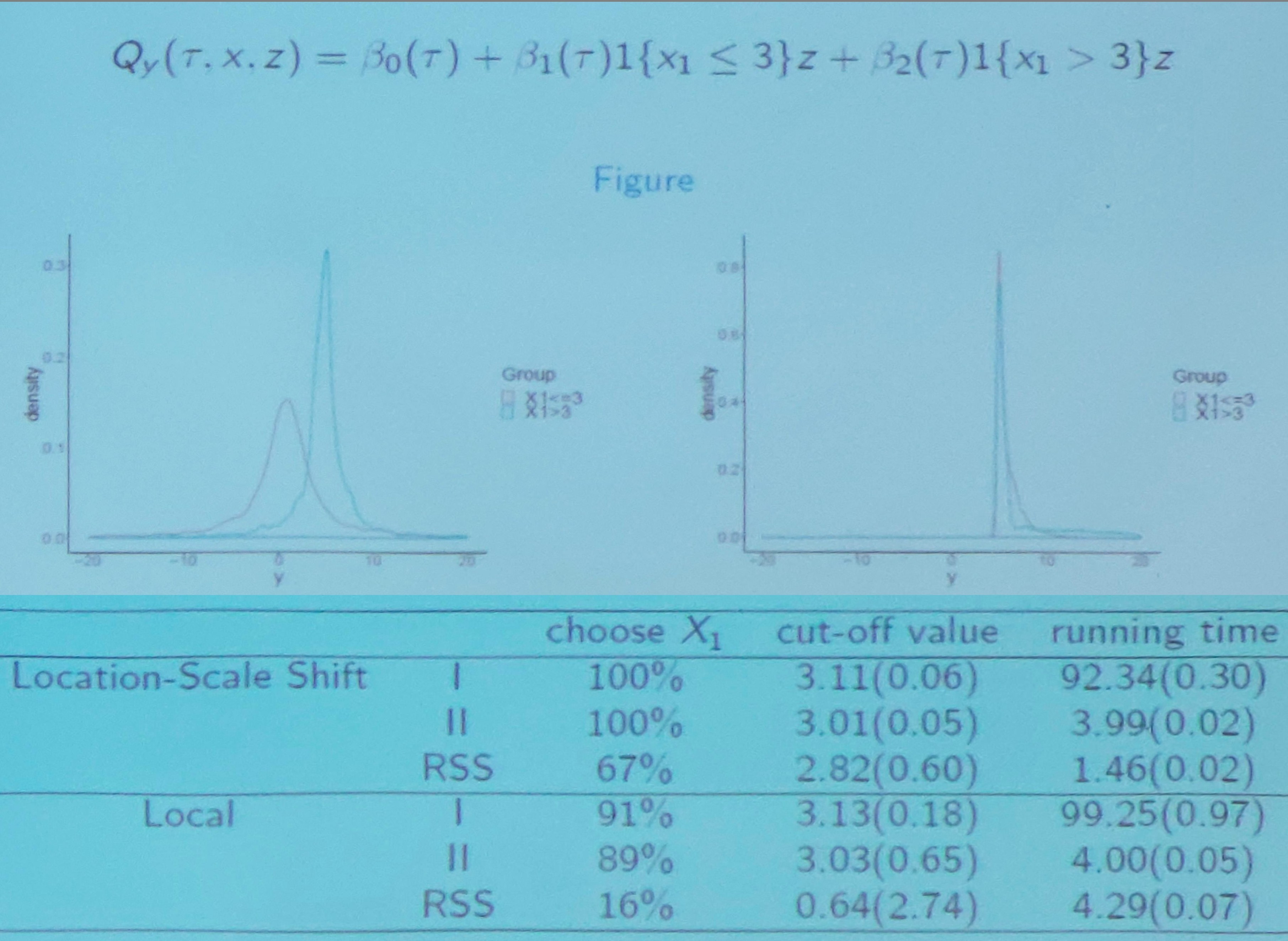
confused about the above two figures.
Algorithm for Conditional Quantile Random Forest
Let $(y_i, x_i, z_i), i=1,\ldots, n_t$ be a training data.
Step 1: Sub-sampling the training data
randomly draw a sub-sample ($m, m\le n_t$ out of $n_t$ samples without replacement) from the training data (not a bootstrap sample!?)
Step 2: Grow a tree
based on the sub-sample, at each split
- randomly draw $p^*\le p$ out of $p$ predictors $x$ as the potential splitting variables ($p^*$ is pre-specified number)
- select the optimal splitting variable using the rank score test statistics
- select an optimal cut-off value of the splitting variable using the proposed criterion
Step 3: Assemble a random forest
The Applications of CQRF
Applications
- Prediction: a new patient with covariates profile $(x^*, z^*)$
- first estimate the individualized conditional quantile effects $\beta(\tau, x^*)$ based on the constructed CQRF
- construct the estimated conditional quantile process ${z^*}^T\hat\beta(\tau, x^*)$
- based on the constructed conditional quantile function, we could obtain: prediction mean, prediction median, prediction interval and predicted risk assessment
- Feature selection: evaluate and rank the importance of the splitting variables
- Precision medicine: assessing individualized treatment effect
Estimating Algorithm of $\beta(\tau, x^*)$
Step 1
drop the vector $x^*$ into each of the tree in the forest $\cT$, and let $N_b(x^*)$ be the terminal node in the tree $T_b$ where $x^*$ lands in
Step 2
for each observation in the training sample, define a tree-based weight
\[\omega_i(x^*, b) = \frac{I(x_i\in N_b(x^*))}{\vert N_b(x^*)\vert}\]and aggregate $\omega_i(x^*, b)$ over the entire forest by
\[\omega_i(x^*) = \frac 1B \sum_{b=1}^B \omega_i(x^*, b)\,,\]where $\omega_i(x^*)$ measures how important the $i$-th observation is in estimating $\beta(\tau, x^*)$.
Step 3
construct weighted quantile regression objective function by
\[L_{\cT, \tau_t} (\beta, x^*) = \sum_{i=1}^n \omega_i(x^*)\rho_{\tau_t}(y_i-z_i^T\beta), t=1,\ldots, t_n\,,\]and estimate $\beta(\tau_t, x^*)$ on a sequence of quantile levels $\tau_t = t/(t_n+1)$ by
\[\hat \beta_{\cT, \tau_t}(x^*) = \argmin_\beta L_{\cT, \tau_t}(\beta, x^*)\,.\]Step 4
construct the coefficient function $\hat \beta_\cT(\tau, x^*)$ by a nature linear spline over $\hat\beta_{\cT,\tau_t}(x^*)$.
\[\hat\beta_\cT(\tau, x^*) = \begin{cases} \hat \beta_{\cT, \tau_1} & \tau < \tau_1\\ \hat \beta_{\cT, \tau_{t_n}} & \tau > \tau_{t_n}\\ \hat \beta_{\cT, \lfloor\tau t_n\rfloor} + \frac{\hat \beta_{\cT, \lfloor \tau t_n\rfloor + 1}(x^*) - \hat \beta_{\cT,\lfloor \tau t_n\rfloor}(x^*)}{ 1/t_n} \left(\tau - \frac{\lfloor \tau t_n\rfloor}{t_n+1}\right) & \text{else} \end{cases}\]Theoretical Properties
Under certain conditions, for fixed $x^*$, \(\sup_{\tau \in[1/(t_n+1), t_n/(t_n+1)]} \Vert \hat\beta_{\cT}(\tau, x^*)-\beta(\tau, x^*)\Vert = o_p(1)\) as $n\rightarrow \infty$.
Conditional Quantile Based Prediction
Conditional quantile process of $y$ given $(x^*, z^*)$:
\[\hat Q_y(\tau, x^*, z^*) = (z^*)^T\hat \beta_{\cT}(\tau, x^*), \tau\in (0, 1)\]- Prediction mean: $E_\cT(Y\mid x^*, z^*) = \int_0^1 {z^*}^T\hat\beta_\cT(u, x^*)du$
Note that $EX=\int xp(x)dx = \int xdF(x) = \int Q_\alpha dF(Q_\alpha) = \int Q_\alpha d\alpha$.
- Prediction median: $\hat Q_y(0.5, x^*, z^*)$
- The $100(1-\alpha)\%$ prediction interval
Conditional Quantile Based Risk Assessment
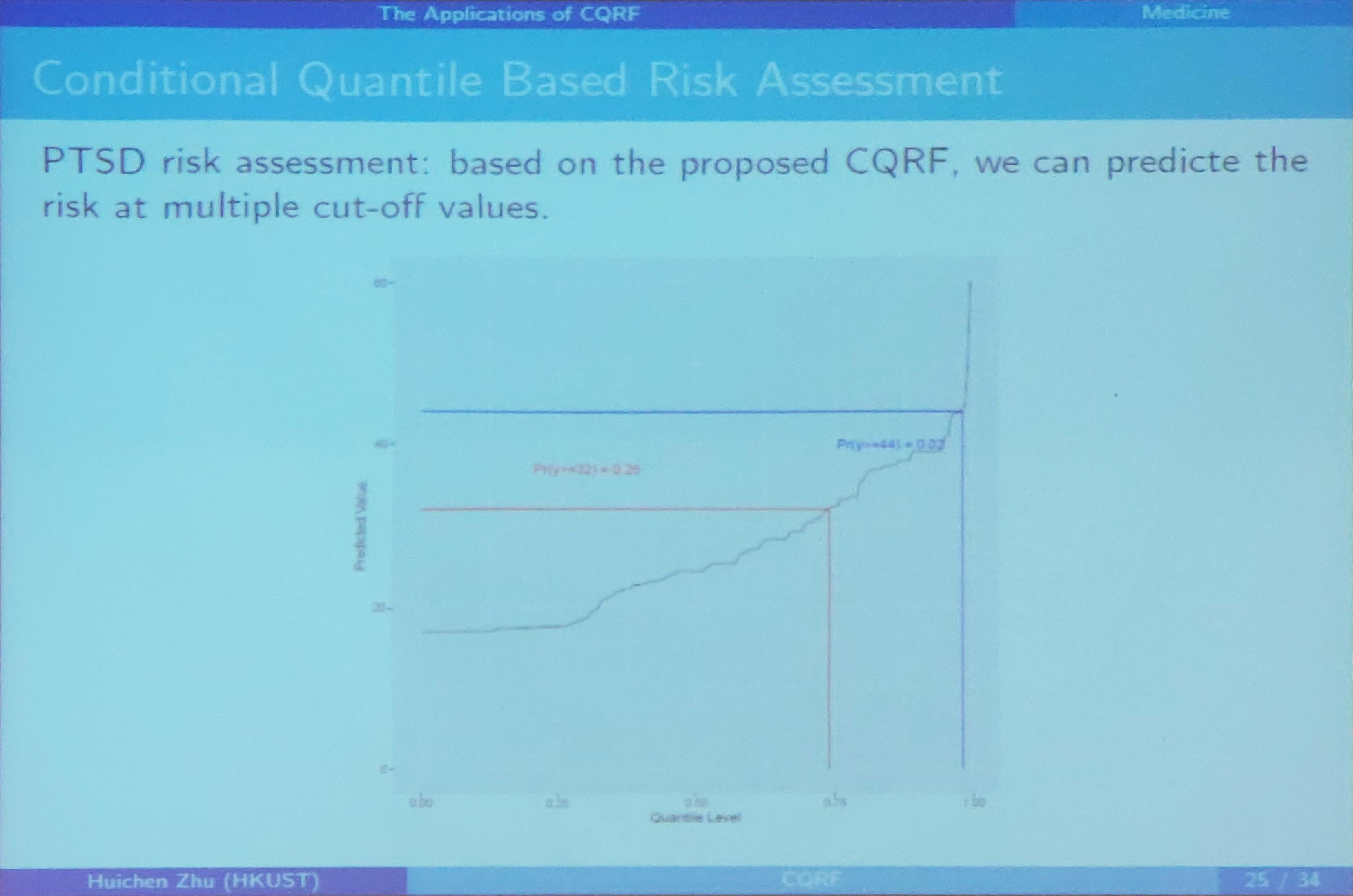
REACH Result
Compare prediction accuracy among the following approaches
- Marginal Quantile RF: treating both $(z, x)$ as splitting variables
- Linear Regression with LASSO: using linear regression, regress one-month PTSD against $(x, z)$, and use a LASSO penalty to select the predictors.
- Random Forest: build the classical mean based random forest using both $x$ and $z$ as splitting variables. The prediction interval is constructed based on predicted mean and standard deviation
- Quantile Regression Forest: The prediction interval is based on the empirical distribution.
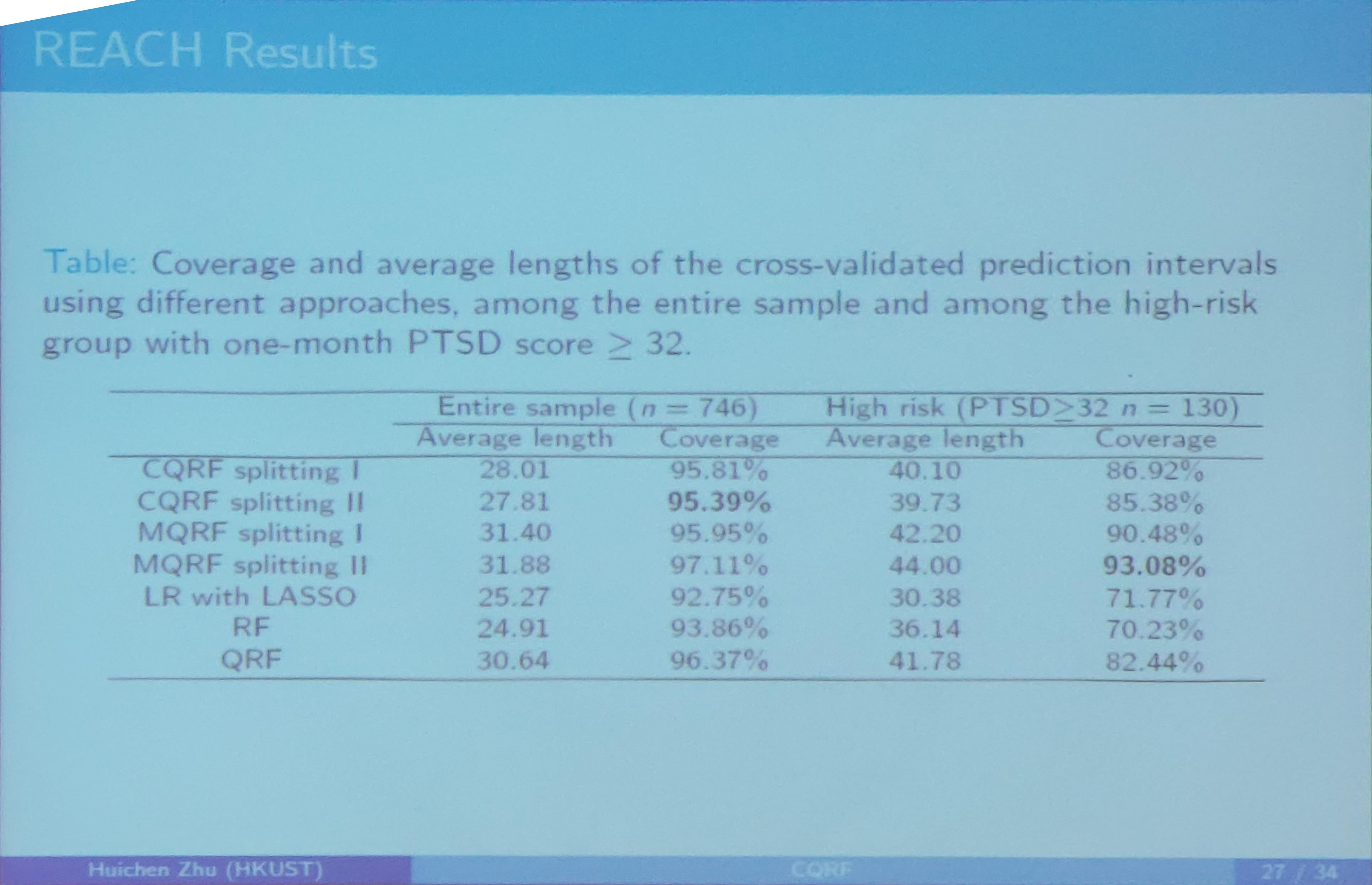
Conclusion for CQRF
a robust and efficient approach for improving the screening and intervention strategies.
- it complements the mean-based approaches and fully takes the population heterogeneity into account.
- the use of conditional quantile regression at each split also provides a convenient way to incorporate domain knowledge to improve prediction accuracy (why bother use $\beta$, directly input $x, z$ into the forest can also combine the domain knowledge)
- incorporate with treatment assignment allow to directly estimate individualized treatment effect for precision care (?? not say related materials)
Ongoing work and future extensions
- explore its applications in gene-environment interactions, and develop a new splitting criterion for large-scale but highly correlated genetics data
- the approach could be extended to a longitudinal outcome, where PTSD score might be measured at different time points. (any details?!)
- the approach could be extended to a survival outcome (any details)
Q & A
Here are the questions and the speaker’s answers, only keywords are recorded.
- Q: How to deal with missing data?
- A: For missed response, directly delete. For covariates, surrogate.
- Q: What if misspecified model in the form?
- A: The non-parametric actually is quite flexible.
- Q: Theories about variable selection, such as some accuracy bounds?
- A: No.
- Q: Compared with other machine methods?
- A: Not enough.